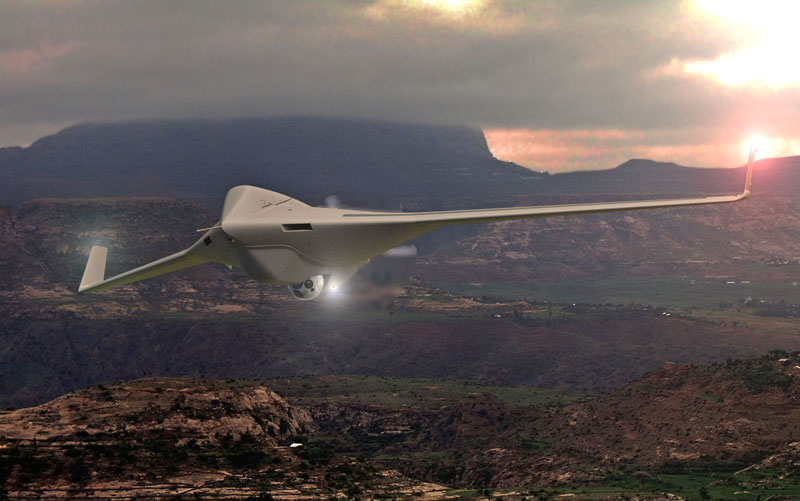AME Unmanned Air Systems (AME UAS) is displaying the Fury 1500 Small Tactical Unmanned Aerial System (STUAS) for the first time at the Paris Air Show 2011. The UAV has recently demonstrated flying powered by a heavy fuel engine. The use of JP8 significantly increases the capability of the system, decreasing the logistical footprint of the system while increasing its endurance substantially.

The Fury 1500 is tailored to address multiple warfighter requirements. Designed for a broad range of missions and long endurance, Fury 1500’s large payload volume and power capacity can support several payloads simultaneously and provide for a flexible, multi-mission capability not currently available with other UAS platforms. The Fury 1500 is a long-endurance, survivable, and runway-independent Multi-INT UAS, providing the large (multi-payload) capacity needed to satisfy critical requirements for the Warfighter.
“The new heavy-fuel high-endurance version of the Fury 1500 will allow for long-duration ISR and EW special missions, ensuring significantly more “on-target” dwell time for special mission operations,” said John Purvis, President and CEO of AME UAS.

The Fury design was developed in response to specific U.S. military requirements. The first model, Fury 1200 made the first flight in 2008; today the company focuses on the Fury 1500 which has similar dimensions and logistical ground footprint but can carry more than twice the payload, and have five times more power on board. Since 2010 AME has been developing the Fury platform for the ‘Sand Dragon’, a lightweight unmanned aircraft carrying miniature dual-band radar and an EO/IR sensor. The U.S. Air Force awarded AME 13.3 million last year, to produce four Sand Dragon systems. The project is an extension of AFRL’s Gotcha program designed to collect volumetric synthetic-aperture radar data from an aircraft circling and staring at an urban area and process it into real-time target tracks. The specific model of the ‘Fury’ platform selected for Sand Dragon identified as ‘Fury B’, has enough payload volume and weight to carry a multi-sensor payload on missions extending more than 24. The heavy-fuel engine was critical to enable operation of the UAV from austere forward sites.
The Fury 1500 can be launched from a rail launcher; the company has recently tested the vehicle with a Robonic premium UAV Launcher System supplied by Robonic Ltd.
Fury is a long-endurance (more than 16 hours), long range (supporting missions at ranges up to 1500 nm (ferry range), Fury 1500 has a cruising speed of 65-95 kt and operating ceiling of 16,000 feet And dash speed of 116 kt. Based on an advanced and efficient 14.3 ft. (3.7 m’) span ‘flying wing’ design the Fury 1500 has a payload carrying capability of 75-125 pounds (over three times its empty weight), the Fury can be configured with different payload bays above or below the forward section or underwing. In addition to the large payload capacity volume, the aircraft has ample on-board power (up to 2,000 watts of continuous power) to drive power hungry payloads such as EW jammers. To protect on board avionics from the strong RF emissions the Fury 1500 offers ‘shielded avionics’ which will also protects the drone in case it is being jammed by the enemy.
According to the manufacturer, the UAV maintain a low acoustic signature while cruising or loitering, therefore maintaining the element of surprise through covert action. To support the Fury 1500 over a long range, three independent datalinks can be employed, offering line-of-sight, beyond line of sight Common Data Link (CDL) compatible communications and an IRIDIUM satellite low-data-rate control link. The company is currently working on the integration of a miniature satellite communications terminal to offer high data rate for video download.
The Fury 1500 has a maximum take-off weight of more than 300 lbs, of which the empty weight is only 65 lbs. (29.5 kg). The maximum payload is 75-125 lbs, plus 27 lbs (12.2 kg) of fuel. The system is designed to be launched and recovered from austere locations including both maritime and littoral environments. The small logistical footprint includes a pneumatic launcher, portable GCS, and collapsible recovery system (water and land). This system employs a field deployable arresting net and a ‘trampoline’ eliminating landing impact, protecting the belly mounted payloads Sealed wire-harnesses and components as well as water proof connectors allow for various types of waterborne recovery.






















